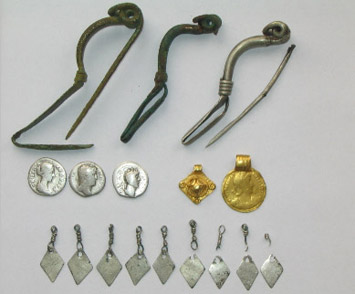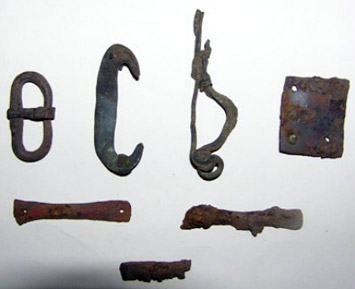Kroczyce, Distr. Zawiercie
A "Hanging Cave" in the Jastrzębnik massif (with an area of 200 m2) discovered about a decade ago in a beech forest near the village of Kroczyce in the Krakow-Częstochowa Upland. The cave contained layer of silt of several metres’ thickness, from which amateur prospectors recovered a great number of archaeological objects, mostly pottery, including a complete wheel-made vessel, and numerous fragments of Krausengefässe (large storage vessels with a substantially thickened rim), rotary querns, three large brooches type A 158, a fragment of an ornamented belt strap-end, an axe pendant and an amber bead made using a lathe. The cave yielded also at least 70 Roman denarii (Vespasian to Didius Julian), including a barbarous imitation and a looped Constantius II solidus, as well as ornaments that have direct analogy in the Lower Danube area and belong in the Dancheny-Brangstrup horizon. Next to two square-shaped pendants decorated with granulation there were 13 silver pendants: 9 lozengic, 2 axe-shaped and 2 crescent-shaped. The youngest specimens belong in the early phase of the Migration Period. The pendants find closest analogy in Sîntana de Mureş-Cherniakhov Culture, especially, in Transylvania and Moldavia. The exact stratigraphic position and association of these finds is not known. As such they cannot be easily attributed to what originally was a uniform assemblage although it almost certain to have included the pendants and presumably, also coins.
Moreover, by the entrance to the cave, the discovery was made, underneath some stones, of a small number of cremation graves from the early Migration Period. Single finds datable to the Migration Period are known also from other caves in the Krakow-Częstochowa Upland. According to a preliminary research hypothesis the caves in the Kraków -Częstochowa Upland were used as refuges by the Przeworsk Culture communities during Hunnic raids, similarly to how the people of late Lusatian Culture used them during Scythian incursions. This hypothesis needs to be confirmed by fieldwork and comparative analyses. The research planned as part of the present Project is expected to improve our understanding of the context of the unusual and unique finds from the cave at Kroczyce.
|
|
|




